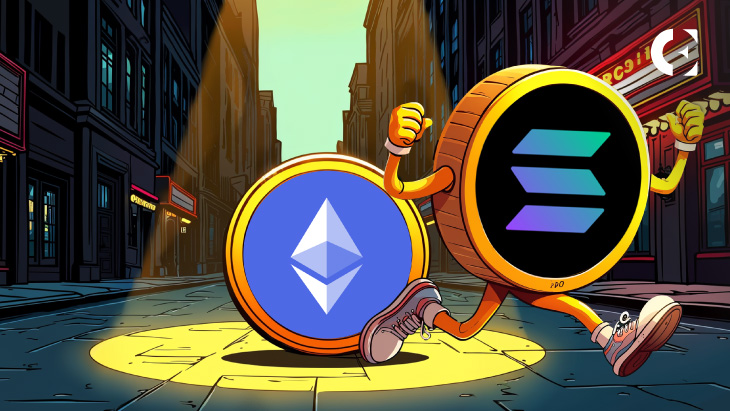- Solana’s transaction fees and revenue growth have surged, rivaling Ethereum’s metrics.
- Ethereum maintains a $400 billion market cap, but Solana’s scalability sets it apart.
- Analysts debate whether Solana could overtake Ethereum as the leading blockchain by 2025.
Solana’s explosive growth in transaction fees and ecosystem activity has positioned it as a strong competitor to Ethereum, according to data from Layergg, a market analyst. With blockchain adoption surging, experts are questioning whether Solana could overtake Ethereum’s dominance by 2025.
By the Numbers: Solana’s Rapid Ascent
The latest data shows that Solana generated $35.53 million in revenue over seven days, compared to Ethereum’s $13.57 million. Solana also reported daily fees of $10.25 million, placing it among the top blockchains.
Additionally, projects within the Solana ecosystem, like Meteora, Raydium, and Jito, have shown impressive metrics. Meteora alone generated $19.54 million in daily fees, taking the top spot among all platforms. Raydium followed with $16.39 million in fees, while Jito recorded $12.25 million, thanks to Maximum Extractable Value (MEV) and staking activity.
While Ethereum still commands a $400 billion market cap, Solana’s $123 billion valuation highlights rapid growth driven by its ability to process over 65,000 transactions per second (TPS) at low costs.
Why Fees and Revenue Matter
Transaction fees are a major indicator of blockchain activity and user adoption. Higher fees suggest strong demand but can push away users if they get too high. Solana’s low-cost model and high throughput have attracted developers and users looking for efficient solutions for decentralized finance (DeFi) and NFTs.
Ethereum, on the other hand, continues to dominate with its extensive developer ecosystem and robust security. The blockchain is also making strides in scalability through layer-2 solutions like Arbitrum and Optimism, aiming to reduce fees and increase capacity post-Merge.
Related: Ethereum Layer 2 Network Base to Break Records with Huge Growth
Ecosystem Wars: Solana vs. Ethereum
Solana’s ecosystem has rapidly expanded, supporting DeFi platforms like Raydium and Serum, as well as NFT marketplaces. This growth has been accompanied by a surge in daily active wallets, challenging Ethereum’s position as the preferred blockchain for developers.
New trends further cement Solana’s position. The ecosystem got a boost from events like the TRUMP token launch and ETF buzz, which have driven increased activity.
Raydium’s fee-sharing and buyback mechanisms have made its tokenomics stronger. And the possibility of new token launches for platforms like Meteora could attract further investment. The influence of celebrity-backed tokens has also contributed to Solana’s growth, making it more attractive to traders and investors.
Meanwhile, Ethereum remains the leader in decentralized applications (dApps) and holds a significant share of the DeFi market. Its long-standing reputation and first-mover advantage have solidified its role as the backbone of blockchain innovation.
Related: $SOL vs. $ETH: Could Solana Overtake Ethereum for the #2 Spot in Crypto?
Could Solana Flip Ethereum?
Solana’s scalability and efficiency give it a strong edge. However, Ethereum’s dominance comes from its large developer network, security, and established infrastructure. The two blockchains may ultimately serve different purposes, with Ethereum focused on security and decentralization while Solana targets speed and cost efficiency.
Disclaimer: The information presented in this article is for informational and educational purposes only. The article does not constitute financial advice or advice of any kind. Coin Edition is not responsible for any losses incurred as a result of the utilization of content, products, or services mentioned. Readers are advised to exercise caution before taking any action related to the company.









